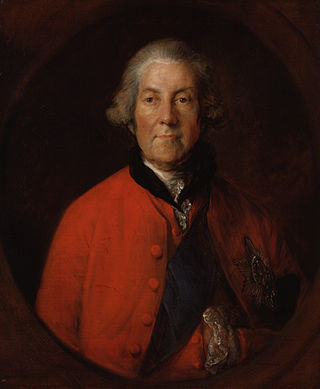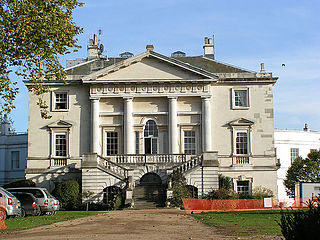
John Stuart, 3rd Earl of Bute,, styled Lord Mount Stuart between 1713 and 1723, was a British nobleman who served as the Prime Minister of Great Britain from 1762 to 1763 under George III. He was arguably the last important royal favourite in British politics. He was the first prime minister from Scotland following the Acts of Union in 1707. He was also elected as the first president of the Society of Antiquaries of Scotland when it was founded in 1780.

Robert Walpole, 1st Earl of Orford,, known between 1725 and 1742 as Sir Robert Walpole, was a British statesman and Whig politician who, as First Lord of the Treasury, Chancellor of the Exchequer, and Leader of the House of Commons, is generally regarded as the de facto first Prime Minister of Great Britain.

John Russell, 4th Duke of Bedford, was a British Whig statesman and peer who served as the Lord Lieutenant of Ireland from 1757 to 1761. A leading member of the Whig party during the Seven Years' War, he negotiated the 1763 Treaty of Paris which ended the conflict. Bedford was also an early promoter of cricket and a patron of the arts who commissioned numerous works from prominent artists, most notably Canaletto.

Archibald Campbell, 3rd Duke of Argyll, 1st Earl of Ilay, was a Scottish nobleman, politician, lawyer, businessman, and soldier. He was known as Lord Archibald Campbell from 1703 to 1706, and as the Earl of Ilay from 1706 until 1743, when he succeeded to the dukedom. He was the dominant political leader in Scotland in his day, and was involved in many civic projects.

John Perceval, 2nd Earl of Egmont, PC, FRS was a British politician, political pamphleteer, and genealogist who served as First Lord of the Admiralty. Of Anglo-Irish background, he sat in both the Irish and British Parliaments. He was the father of the Regency Era Prime Minister Spencer Perceval.

Princess Amelia Sophia Eleonore of Great Britain was the second daughter of King George II of Great Britain and Queen Caroline. Born in Hanover she moved to England when her grandfather, George I became king. Amelia lived a solitary existence and died in 1786 and was the last surviving child of her parents.

Maria, Duchess of Gloucester and Edinburgh was a member of the British royal family. She was titled Countess Waldegrave from 1759 to 1766, as a result of her first marriage to James Waldegrave, 2nd Earl Waldegrave. Her second husband was Prince William Henry, Duke of Gloucester and Edinburgh, whom she married in 1766.

White Lodge is a Grade I listed Georgian house situated in Richmond Park, in the London Borough of Richmond upon Thames. Formerly a royal residence, it now houses the Royal Ballet Lower School, instructing students aged 11–16.

Charles (Medows) Pierrepont, 1st Earl Manvers was a British naval officer and politician who sat in the House of Commons from 1778 to 1796 when he was raised to the peerage as Viscount Newark.
Gentleman of the Bedchamber was a title in the royal household of the Kingdom of England from the 11th century, later used also in the Kingdom of Great Britain. A Lord of the Bedchamber was a courtier in the Royal Household; the term being first used in 1718. The duties of the Lords and Gentleman of the Bedchamber originally consisted of assisting the monarch with dressing, waiting on him when he ate, guarding access to his bedchamber and closet and providing companionship. Such functions became less important over time, but provided proximity to the monarch; the holders were thus trusted confidants and often extremely powerful. The offices were in the gift of The Crown and were originally sworn by Royal Warrant directed to the Lord Chamberlain.
The following is the Jacobite line of succession to the English and Scottish thrones as of the death of Anne, Queen of Great Britain, on 1 August 1714. It reflects the laws current in England and Scotland immediately before the Act of Settlement 1701, which disqualified Catholics from the throne.
Sir Sidney Meadows was a British Member of Parliament and Knight Marshal of the King's Household during the reign of George II and George III.
Richmond Lodge was a historic property located near the River Thames in Richmond, London, in what is now known as Old Deer Park, lands belonging to the historic Richmond Palace. It was located close to the King's Observatory. It should not be confused with Pembroke Lodge or the White Lodge, both in Richmond Park, or a variety of other similarly-named properties.
Sir Philip Meadowes or Meadows (1672–1757) was an English politician and diplomat.
Philip Meadows (1708-1781) was Deputy Ranger of Richmond Park (1761-1781).








